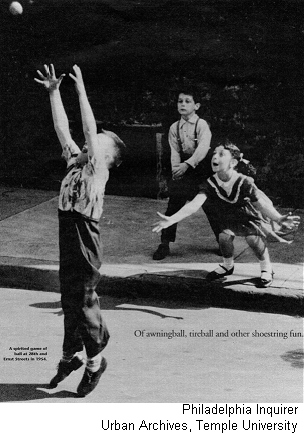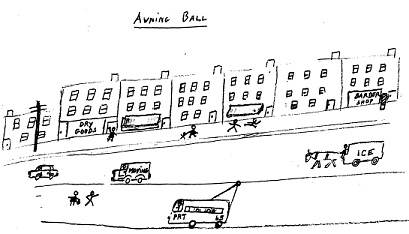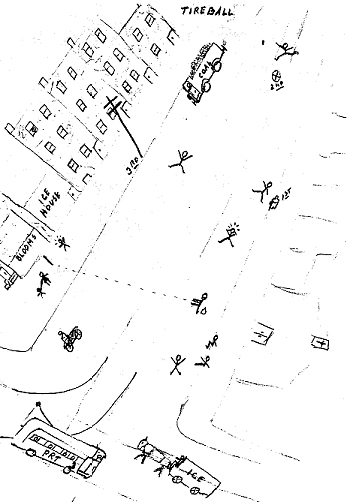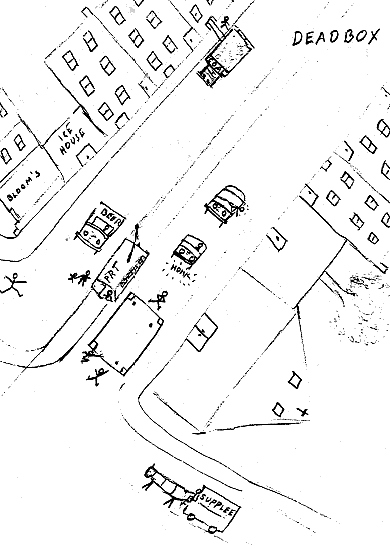|
Published in the Philadelphia Inquirer Magazine, on
June 20, 1999. The way we played By Sidney B. Kurtz
The kids of my old neighborhood, Seventh and Montgomery, were hemmed in by two- and three-story brick rowhouses. School yards were small and crowded. Soccer fields were nonexistent, that sport practically un-known in America at the time. The nearest football field was Franklin Field, used only by the University of Pennsylvania. The baseball fields in Fairmount Park required a three-mile trolley ride, 15 cents each way, an amount most of us couldn't afford. So we looked inward for our salvation. The result was a burst of amazing creativity. Most street games revolved around the pimpleball, so called because its surface was covered by small bumps. This hollow rubber ball was about the size of a baseball, light and easy to grip. It cost a nickel, and we chipped in our precious pennies to buy it at Bloom's Candy Store. The pimpleball never died - when it split, we'd cut it in two and play halfball. Here are some of our inner-city inventions - games that we boys played over and over, day after day, year after year. (Girls had games of their own - jump rope, hopscotch, jacks.) When we tired of one, we moved on to another.
Awningball But until then, we played awningball. Either two boys played or two teams (two boys each) opposed each other. The goal: Keep the ball on the awning. If it hit the ground or rolled off either end, it was a point for the other player or team. We'd run back and forth hitting the ball with our palms - no fists allowed - forcing shoppers to detour off the sidewalk into the street or under the awning. There was a certain art to the game -placing the ball where the other guy couldn't reach it, or tapping it lightly, barely landing it on the front edge of the awning. It was an intricate ballet of graceful arms, twisting bodies and fast feet, particularly when Mr. Shuster's broom showed up. Then it would be time to move on to the next awning.
Handball (self-pitch)
No pitcher was needed: The batter pitched to himself. He held the pimpleball in his left hand - right if he was left-handed. Funny, I don't remember any left-handers in our bunch. Maybe it was our Eastern Euro-pean heritage. Rumors abounded that left-handed immigrants were kept in special "lefty" rooms at Ellis Island and then shipped back to Russia. Anyway, the batter tossed the ball about three feet into the air and batted it with his fist. If it sliced off to the side before reaching first or third, it was a foul ball. Once it passed between those bases, it was fair. The fielders tried to catch the ball on the fly or throw the batter out before he reached first. In some cases doubles, triples or even home runs were achieved by a particularly long drive or sloppy fielding. Bunting was verboten. The game was really baseball without a bat or a pitcher. And we had a few things the major leaguers didn't have - fireplugs, telephone poles and manholes.
Tireball
We were constantly devising all sorts of solutions to problems such as this. One answer was a four-inch length of bicycle tire. A tireball was an admirable alternative to the halfball. Thrown end over end and hit by a bat (a broomstick smuggled from home with the broom end left on the closet floor for mom to scratch her head over), it sailed re-markable distances. A bit tougher to catch than the symmetrical pimpleball, it merely presented another challenge to overcome. Tireball was played up and down the length of the street, across the street or at an intersection using the four corners as bases, the pitcher in the center dodging cars, horses and trolleys. Up-and-down-the-street tireball was our favorite. It gave us a chance to see who could hit "the ball" the farthest. We played most often on Seventh Street, just south of Montgomery between the Methodist church and Bloom's Candy Store. As on Randolph Street, a fireplug, telephone pole and a manhole had been conveniently placed by the utility companies. The last tireball game on our favorite "field" took place one humid summer after-noon in the late 1930s. The teams were lined up and the game was proceeding without too much incident. There were the usual delays - horses, cars and trolleys, an occasional pedestrian struck by a tireball, an occasional player struck by a pedestrian - and so on. It was hot, and we were getting thirsty. But the game was tied. Try as we might, neither team could score the winning run. I can still see the batter who broke up that last game - poised, confident, determined. Like the mighty Casey, he took a heroic swing. The bat hit the tireball a resounding smack, sending it far up Seventh Street. But the batter's hands were wet with perspiration, and he let go of the bat. The bat sailed behind him and across the street, between two pedestrians waiting for a trolley, and through Bloom's window. The sound of breaking glass was quickly followed by Mrs. Bloom screaming in broken English and preciseYiddish and the runners heading in all directions of the compass. The tireball landed on a parked car far up the street. It might have been a home run - we'll never know. It was a long time before we again ventured into Bloom's Candy Store.
Deadbox Player No. 2 did the same, but he had an advantage denied to No. 1. He was allowed to knock No. 1 out of the deadbox, requiring him to start over. If there was a player No. 3, he could do the same to 1 and 2. The first player to negotiate a complete transit of the bases was the winner. This often took some time since so much pleasure was derived from knocking the last guy's cap under the wheels of a passing car or trolley. As we concentrated on our bottle caps, the view from our bent-over and prostrate positions was of automobile and trolley wheels, pedestrians' and horses' feet and the occasional bug that found the deadbox a convenient shortcut to wherever it was going. As in self-pitch handball, tireball, half-ball, and later, baseball, the idea was to get "home" - that's all that mattered. We didn't smoke, do drugs or use alcohol (that is, on a regular basis), but we were obsessed with street games of all kinds, and not just the ones I've mentioned. We also played wireball, wallball, lay-sheepy-lay, hit-the-penny-with-the-nut, peggee, buck-buck, bounce-the-cap and touch football. The addiction stayed with us for years to come, teaching us to play by the rules, building character and breaking a few windows along the way. Sidney B. Kurtz is the author of a family memoir, The Jewish Rectangle: An American Adventure. He lives in Pennsauken. |

 The
streets of North Philadelphia in the 1930's '40s and '50s served a dual
purpose - transportation routes for automobiles, trolley cars and the
disappearing horse and wagon, and playgrounds for youngsters.
The
streets of North Philadelphia in the 1930's '40s and '50s served a dual
purpose - transportation routes for automobiles, trolley cars and the
disappearing horse and wagon, and playgrounds for youngsters. This
game required two items - a store awning (preferably already lowered)
and a pimpleball. On Seventh Street between Montgomery and Berks was
an assortment of small stores. Most had awnings to protect them from
the sun. We'd roam up and down the street casing the awnings before
picking one with just the right angle. Shuster's Fruit Store was the
best, but sooner or later the dirt-covered ball would plunk into the
tomatoes or grapes, and Mr. Shuster would rush out and sweep us away
with his broom - notwithstanding the presence of his son among the players.
Dave had little influence with his father.
This
game required two items - a store awning (preferably already lowered)
and a pimpleball. On Seventh Street between Montgomery and Berks was
an assortment of small stores. Most had awnings to protect them from
the sun. We'd roam up and down the street casing the awnings before
picking one with just the right angle. Shuster's Fruit Store was the
best, but sooner or later the dirt-covered ball would plunk into the
tomatoes or grapes, and Mr. Shuster would rush out and sweep us away
with his broom - notwithstanding the presence of his son among the players.
Dave had little influence with his father. Self-pitch
handball (no relation to formal handball) sent us over to a factory
district on Randolph Street. It had two big advantages-it was nonresi-dential
and the street was wide. Any number of kids could play handball - as
few as two on a team or up to five or six. Outfielders and infielders
were a must. We laid out bases - first and third on opposite sidewalks
(fire-plugs and telephone poles were ideal) and for second, a manhole
in the middle of the street.
Self-pitch
handball (no relation to formal handball) sent us over to a factory
district on Randolph Street. It had two big advantages-it was nonresi-dential
and the street was wide. Any number of kids could play handball - as
few as two on a team or up to five or six. Outfielders and infielders
were a must. We laid out bases - first and third on opposite sidewalks
(fire-plugs and telephone poles were ideal) and for second, a manhole
in the middle of the street. Sometimes
the pimpleball took an involuntary leave of absence - to the top of
a roof, through a living room window or into a smelly sewer. While balls
were rescued from sewers by volunteers held upside down by their feet,
a pimpleball on top of a three-story roof was rarely retrievable. Destined
to spend the rest of its days among the tar and pebbles, bleached by
the summer sun, pelted with sleet and snow, it lay forever, a limp,
deflated relic of its former self, never again to arch over a trolley
wire or smack a synagogue wall. Its life was over. What to do in such
a crisis? And with no nickels available?
Sometimes
the pimpleball took an involuntary leave of absence - to the top of
a roof, through a living room window or into a smelly sewer. While balls
were rescued from sewers by volunteers held upside down by their feet,
a pimpleball on top of a three-story roof was rarely retrievable. Destined
to spend the rest of its days among the tar and pebbles, bleached by
the summer sun, pelted with sleet and snow, it lay forever, a limp,
deflated relic of its former self, never again to arch over a trolley
wire or smack a synagogue wall. Its life was over. What to do in such
a crisis? And with no nickels available? So-called
because of the player's proximity to death or injury by horse, auto,
trolley or Mrs. Bloom, deadbox was laid out on the street between the
trolley tracks and the curb. Using chalk "borrowed" from school, we
marked off a 6-by-6-foot square. Each corner represented a base. The
only equipment needed was a soda bottle cap and a strong middle finger
to propel it around the box. Each player used his own bottle cap and
was allowed one "bat" at a time. For example: Player No. 1, knees to
the street and gauging distance and drift due to the slope of street
and the distraction of traffic, flicked the cap toward first base. If
he reached the base successfully, he got another turn. Otherwise, the
cap stayed where it lay until the next turn.
So-called
because of the player's proximity to death or injury by horse, auto,
trolley or Mrs. Bloom, deadbox was laid out on the street between the
trolley tracks and the curb. Using chalk "borrowed" from school, we
marked off a 6-by-6-foot square. Each corner represented a base. The
only equipment needed was a soda bottle cap and a strong middle finger
to propel it around the box. Each player used his own bottle cap and
was allowed one "bat" at a time. For example: Player No. 1, knees to
the street and gauging distance and drift due to the slope of street
and the distraction of traffic, flicked the cap toward first base. If
he reached the base successfully, he got another turn. Otherwise, the
cap stayed where it lay until the next turn.